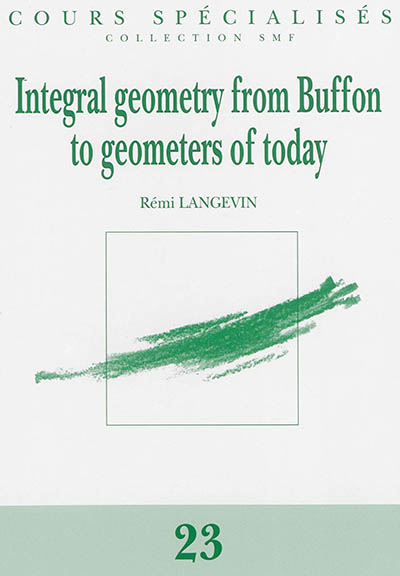en savoir plus

Carte fidélité
Permet à tous ses détenteurs d'obtenir 5% de réduction sur tous les livres lors du retrait en magasin (réduction non cumulable avec les réductions de type étudiant).
Offre également un certain nombre d'avantages auprès de nos partenaires.
Wishlist
Avec les favoris, retrouvez dans un espace les sélections effectuées au fur et à mesure de vos navigations dans le site.
Constituez pour votre usage personnel vos listes de livres en prévisions d'achats futurs et votre sélection d'articles, dossiers, événements, vidéos ou podcasts préférés ou à découvrir plus tard...
Il suffit simplement de cliquer sur "Ajout Favori" sur chaque page qui vous intéresse pour les retrouver ensuite dans votre espace personnel.
Requiert un compte Mollat
Mes Alertes
Requiert un compte Mollat
Integral geometry from Buffon to geometers of today
Auteur : Rémi Langevin
en savoir plus
Résumé
Un ouvrage consacré à l'histoire de la géométrie intégrale, aussi appelée théorie des probabilités géométriques, qui a accompagné pendant plus de deux siècles le développement des probabilités, de la théorie de la mesure et de la géométrie. ©Electre 2025
Lire la Quatrième de couverture
Réduire la Quatrième de couverture
Integral geometry from Buffon to geometers of today
Integral geometry, also called theory of geométrie probabilities, followed during more than two centuries the development of probability, measure theory and geometry.
The birthdate of integral geometry is for us the publication of Buffon's « traité d'arithmétique morale » in 1777. It is only almost a century later that Crofton will explicit what is a measure on a continuous set like the set of lines of the plane. The meaning of Cauchy-Crofton formula : « the length of a plane curve is proportional to the weighted measure of the set of lines intersecting it », is now clear.
At the beginning of the twentieth century, integral geometry considers shapes. Minkowski, in 1901, found the first relation between a curvature integral on the boundary (...) of a convex body (...), and the measure of the planes intersecting (...). Steiner, Blaschke, Chern and Santalô provided many results about curves and surfaces in the same spirit.
Topology played a role mainly during the second half of twentieth century. A seminal example is Fenchel's statement: the total curvature of a closed curve embedded in Euclidean space (...)3 is larger than 2(...). Moreover, we know now that, if the curve is knotted, the total curvature is larger than 4(...), showing that « more complicated topology demands more complicated geometry ». We will present many more examples, in Euclidean space or in space-forms.
Complex curves, foliations of space-forms, also provide results of the same type.
Until now, we considered ambient spaces endowed with a Riemannian metric. The geometry of the curves, surfaces or foliation was observed locally via curvature functions. Conformal geometry behaves differently: we will often need to involve the local geometry of pairs of points. The counterpart will be measured observing the relative position of curves or surfaces in (...)3 with spheres. The non-compacity of the set of 2-spheres of (...)3 also contributes to change the rules of the game. We will describe the first results obtained in this direction.
Fiche Technique
Paru le : 15/12/2015
Thématique : Mathématiques Appliquées
Auteur(s) : Auteur : Rémi Langevin
Éditeur(s) :
Société mathématique de France
Collection(s) : Cours spécialisés
Série(s) : Non précisé.
ISBN : 978-2-85629-822-0
EAN13 : 9782856298220
Reliure : Broché
Pages : 284
Hauteur: 25.0 cm / Largeur 18.0 cm
Poids: 0 g
